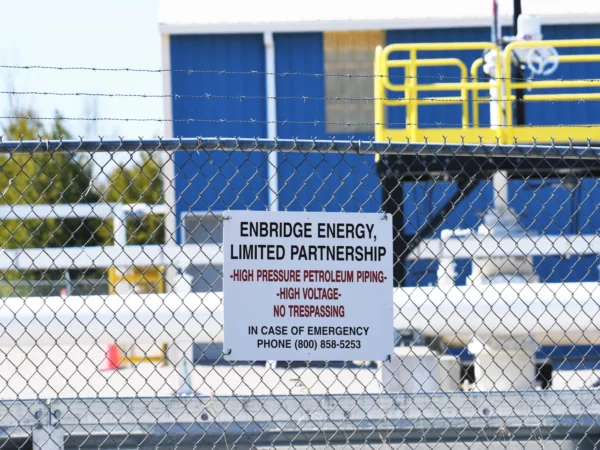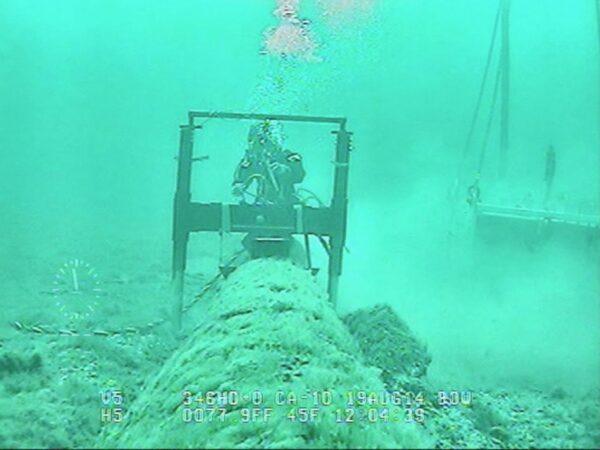
By Sarah Cwiek, Michigan Radio
The Great Lakes News Collaborative includes Bridge Michigan; Circle of Blue; Great Lakes Now at Detroit Public Television; and Michigan Radio, Michigan’s NPR News Leader; who work together to bring audiences news and information about the impact of climate change, pollution, and aging infrastructure on the Great Lakes and drinking water. This independent journalism is supported by the Charles Stewart Mott Foundation. Find all the work HERE.
The Biden Administration says it has no plans to shut down Enbridge Energy’s Line 5, White House spokeswoman Karine Jean-Pierre said during a press conference on Tuesday.
Jean-Pierre says the U.S. and Canada will begin negotiations over the pipeline that runs through the Straits of Mackinac after Canada invoked a 1977 treaty to resolve pipeline disputes on behalf of Enbridge, a Canadian company.
Jean-Pierre called Canada a “close ally and key partner” to the United States, and the administration expects negotiations to be “constructive.”
“These negotiations and discussions between the two countries shouldn’t be viewed as anything more than that, and not an indicator the U.S. government is considering shutdown,” Jean-Pierre said. “That is something we’re not going to do.”
Canada invoked the treaty in the midst of a legal battle between the energy company and the state of Michigan. Governor Gretchen Whitmer and Attorney General Dana Nessel have sued Enbridge to shut the pipeline down. The case is currently stalled in federal court, after attempts at mediation failed. Enbridge ignored a state order to cease operations in May, and the state’s position is that the company is now trespassing by failing to shut down the pipeline.
Enbridge wants to build a tunnel around a replacement section of Line 5 instead. Jean-Pierre noted that the U.S. Army Corps of Engineers is currently conducting an environmental impact study on that proposal, stressing that’s separate from the issues surrounding the “current pipeline.”
Governor Whitmer’s office did not immediately respond to requests for comment on Jean-Pierre’s statement.
Editor’s note: Enbridge is one of Michigan Radio’s corporate sponsors.
Catch more news on Great Lakes Now:
White House: US will discuss Michigan pipeline with Canada
Enbridge temporarily stops Michigan pipeline due to protests
Featured image: Enbridge
1 Comment
-
The government of Canada has thrown in with the Canadian corporate entity, Enbridge, arguing that the 1977 Agreement between the Government of the United States and the Government of Canada concerning Transit Pipelines (“1977 Treaty”) should preclude Michigan’s actions on the Line 5 pipeline, where it utilizes an easement granted by the State of Michigan.
While Michigan’s actions may have the effect of impacting pipeline operation, those actions are not a regulation of the pipelines or of pipeline safety. They are simply enforcing terms of the easement that was granted to Enbridge’s predecessor, which Enbridge (or one of its many corporate subsidiaries) subsequently assumed and is bound by.
There are two major issues in the current Line-5 Pipeline situation: The first deals with the current dual pipeline crossing the Straits of Mackinac, on or suspended above the benthic surface. The other issue is whether the proposed tunnel beneath the floor of the Straits of Mackinac should be built. These are two distinct but related issues.
The matter of the dual pipelines is one of risk to the health of the Great Lakes. When that pipeline was laid, some six and a half decades ago, it had a projected life expectancy of fifty years, when constructed and maintained as designed. As of the year 2021, that pipeline has exceeded its design life by 36%.
Compounding the clear issue of its age, the pipeline’s owners have failed to maintain the line as it was designed. Vast sections of the line have become suspended above the bottom of the Straits, without the supports that its design specified. The pipeline, as it exists today, is not the same pipeline that was approved. Failure to maintain the pipeline, according to its design specifications, is an ongoing breach of the easement agreement that allows that pipeline to exist and to operate within the waters of the State of Michigan.
Structural deficiencies that have plagued the Straits section of Line 5 are exacerbated by the decades of stress imposed by powerful currents where it dangles above the bottom of the Straits. Unsupported sections were never designed to be subjected to constant back-and-forth flexion from the ever-changing currents that exist in the Straits. Consider the roughly 25,000 days that this pipeline has been in place, affected by powerful currents and by ever-shifting weather patterns: How many times can a metallic pipe be flexed back and forth without metal fatigue? The current condition of these two pipelines is of significant concern, as a metallurgical failure would be catastrophic.
Enbridge’s current attempt to bolster the pipelines by adding support structures is a Band-Aid approach that constitutes a redesign of the pipeline itself. That redesigned and retrofitted pipeline is not what was engineered, studied and approved for placement in the Straits. Maintaining it in that fashion constitutes an ongoing breach of the easement agreement, absent proper engineering studies and approvals.
The Line-5 pipeline, even if it had been maintained as it was designed, has far exceeded its designed life expectancy. As that line continues to age, unacceptable risks mount. Over the decades that Line 5 has been in place, there have been significant changes to the floor of the Straits, due to erosion and shifting of benthic material. The way that the pipeline is now suspended across the bottom of the Straits is chillingly similar to an arresting cable on an aircraft carrier: Snagged by one anchor dragged from a passing freighter – potentially 136 million pounds or more, travelling at 10+ knots – those pipelines, and the pristine waters of the Straits, would be history.
The second major issue is regarding the proposed tunnel that would replace the dual lines under the Straits. Enbridge’s proposal to construct a tunnel under the straits is a massive project that should only be undertaken with appropriate study, engineering, and approvals. Some people see the proposed tunnel as a canard; a tactic to delay decommissioning the existing dual pipelines, keeping them in profitable operation until fossil fuels become less profitable. Shifts in consumer and societal behaviors may make this obsolescence inevitable, although the timeline is subject to debate.
Construction of the proposed tunnel would arguably resolve the immediate issue of the dual pipelines’ vulnerabilities and direct risks to the waters of the Straits area. Its completion would still not resolve ongoing disputes with First Nations tribes whose lands the ground-based segments of the pipeline traverse. But those are issues that Enbridge must deal with.
Michigan’s action on the dual Line-5 pipelines is about the easement and the agreement that allows Enbridge to operate within that easement. It is incumbent upon Enbridge to fulfill its obligations under the easement agreement in order to continue operating there. Enbridge has failed to fulfill those obligations and their failure to do so is not a failure on the part of the State of Michigan. If the consequences of Enbridge’s violations of the easement agreement end its ability to utilize the easement across the Straits of Mackinac, that is on Enbridge. Any resulting disruption of its ability to move its products would only be incidental to enforcement of that easement agreement.
The bottom-line on the Canadian government’s intercession in the easement dispute is this: Should the existing pipelines fail, whether due to an anchor snag, metal fatigue, or other catastrophic event, what section of the 1977 Treaty would Canada then try to invoke to keep profits flowing for Enbridge?




